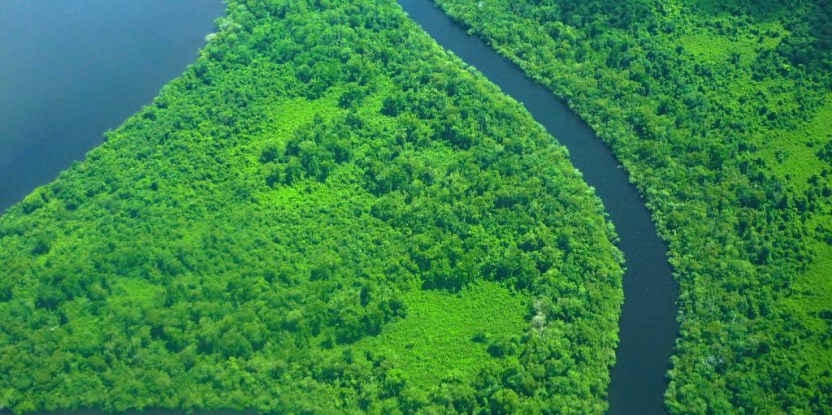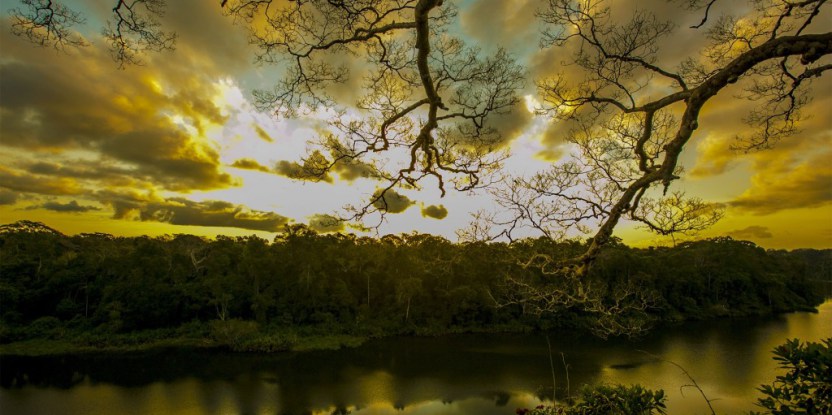BOGOR, Indonesia—When Brazilian researcher Maria Fernanda Gebara thinks of her first visit to the Amazon municipality São Félix do Xingu in 2010, the first thing she remembers is the smoke.
“My eyes were burning all the time working there,” she said. The smoke came from fires lit by farmers, burning the rainforest to convert it to pastureland.
“All I could smell was the fires, and the dust, because it was the dry season—it really was a no-man’s land where you could do anything you wanted,” Gebara said.
“My first impression was that, if REDD+ works here, it can work anywhere in the world.”
REDD+ means reducing carbon emissions from deforestation and forest degradation, a UN-backed idea for mitigating climate change that emerged in 2007 and has since been experimented with in pilot initiatives across the tropics.
Gebara was in São Félix do Xingu as part of a Center for International Forestry Research (CIFOR) team that has analyzed and compared 22 such initiatives in Latin America, Africa and Asia—and published those findings in a new book.
And in 2010, São Félix do Xingu—an enormous, country-sized municipality in Brazil’s Para state—was the front line of global deforestation.
From 2001, it recorded some of the worst deforestation in the Amazon, and in 2008 was added to the Brazilian government’s ‘black list’ of the 43 municipalities with the highest deforestation rates—meaning, among other things, farmers in the jurisdiction were blocked from accessing credit for cattle ranching and related activities.
A whole series of initiatives—municipal, state, national and NGO-run—set about trying to tackle the deforestation problem, including international NGO The Nature Conservancy (TNC), with a program that was originally labelled a REDD+ initiative, but is now called “The Sustainable Landscape Pilot Program.”
It’s this program that Gebara went to São Félix do Xingu to investigate (read her chapter here).
The initiative aims to involve different local actors to create a politically and economically favorable scenario for reducing deforestation.
SUSTAINABLE LANDSCAPES, UNINTENDED CONSEQUENCES
TNC chose São Félix do Xingu “because it is kind of like a microcosm of the Amazon,” Gebara said.
“You can find the different realities of land ownership, land uses, and actors—smallholders, family-run farms, large ranchers, indigenous lands, mining—so it’s very interesting to think about solutions in this sort of vast landscape,” she said.
And TNC uses a “landscape approach,” involving this diverse array of actors in the program. To do this, the initiative needed to adopt a mix of different strategies and incentives to encourage deforestation reduction, such as land-use zoning, technical assistance and sustainable production alternatives for smallholders; financing and management for indigenous areas; and assistance with enforcement of environmental laws.
Some were already complaining they were at risk of starving because they didn’t grow enough food for that season
TNC also played a key role as semi-neutral broker between the different interest groups in the landscape, Gebara said.
“They helped to create a sense of everybody needing to work together to change the situation, to remove the municipality from the blacklist, to be out of the embargo and to achieve the deforestation rates that the Ministry of Environment required,” she said.
One of the early strategies TNC focused on, Gebara said, was to clarify land tenure—a persistent issue for REDD+ initiatives from Peru to Indonesia, as not only does unclear tenure increase people’s feeling of insecurity, but who owns the forest needs to be clear if those owners are going to receive benefits for keeping it standing—or sanctions for cutting it down.
With the new Forest Law (12.651/2012), Brazil made it mandatory for all rural properties to be mapped and registered through a government system known as CAR (Cadastro Ambiental Rural)—the first step towards clarifying tenure. One of the conditions for municipalities to make it off the deforestation blacklist is for at least 80 percent of private properties to be registered.
TNC provided financial technical support to make this happen in São Félix do Xingu—and more than 80 percent are now signed up to the CAR.
Their success, though, had unintended consequences: Although deforestation in the municipality as a whole has fallen, it actually went up in the areas that had been registered.
Why? Because once property owners sign up to CAR, they can access the government agriculture and cattle subsidies they were blocked from receiving because of the blacklist—and this gave them the money they needed to start clearing more forest for pasture, Gebara says.
This is an important lesson, she says: Proponents in Brazil need to combine CAR registration with other incentives. TNC is starting to do this, Gebara says, educating people on other kinds of government credits they can access instead if they move away from deforestation, such as the federal Low Carbon Agriculture (ABC) Program.
DELAYS MATTER
The TNC program in São Félix do Xingu, as many REDD+ pilot initiatives, suffered from the global uncertainty in the past few years about the future of REDD+ and the lack of a global agreement on climate change that includes deforestation.
And it was the poorest small farmers in the municipality that suffered the worst impact, Gebara says.
By 2013, implementation of the program’s initiatives was delayed because the carbon funding TNC had anticipated still hadn’t materialized, due to global uncertainty about REDD+.
“I think the international delay was really critical in this case because donors, implementers and proponents were waiting to see what would happen, and this delay was really bad on the ground,” she said.
While smallholders had reduced deforestation mainly because of the federal embargo, many told Gebara in 2013 that they felt they were getting nothing in return.
“They were worried about what would happen. Some were already complaining they were at risk of starving because they didn’t grow enough food for that season, and others were already leaving for other municipalities where they could cut enough forest to graze their cattle or plant crops,” she said.
Larger landholders had more ability to adapt, but life is precarious for the poorest subsistence farmer, Gebara said.
“It is increasing social inequality. Because they are stopping cutting down trees—which is good, as smallholders are an important driver of deforestation in this municipality—but it’s bad in terms of social impact,” she said.
One community member told Gebara the command-and-control and monitoring strategies like the embargo and the land registration program “stop the smoke but do not solve the problem”—meaning that without viable alternatives for smallholders, deforestation reductions are likely to be only short term.
TNC are implementing more interventions this year—but Gebara says the whole process needs to happen faster if smallholders are going to be convinced of the benefits.
“People on the ground need to see that things are happening. Despite all the information TNC provided, smallholders need to see the alternatives that REDD+ is supposed to create,” she said.
“Sometimes I think we talk a lot, as we are worried about proper informed consultation. In the case of São Félix they are starting to get tired of talking, they want to see alternatives.”
IS IT REDD? IT’S NOT BLACK AND WHITE
The TNC initiative in São Félix do Xingu no longer calls itself a REDD+ project.
It’s one of several Brazilian and Cameroonian initiatives that have rejected the REDD+ label, according to Erin Sills, the lead author of CIFOR’s new book, “REDD+ on the Ground.”
“In Brazil and across lots of the initiatives, the proponents have been very concerned about managing expectations in relation to REDD+,” she said.
“There’s been concern about commodification, and the idea it would attract ‘carbon cowboys’ and people who wanted to grab forest resources in order to profit from carbon credits—and that led them to think that the REDD+ label was creating more controversy than helping them,” she said.
REDD+ is about changing institutions, building coalitions, as TNC has been trying to do
In TNC’s case, “now they’re clearly thinking that REDD+ in and of itself is not really going to address the climate change mitigation problem, and they need to think more broadly across sectors and across stakeholders.”
In the process, Maria Fernanda Gebara says, the São Félix do Xingu program shows how REDD+ is losing some of the elements that made it originally such a novelty—such as its narrow focus on climate change mitigation and evidence-based funding.
So is it still REDD+? And is it working?
“It depends on how you see REDD+. I don’t really see REDD+ as a market–based approach, just about payments for environmental services. For me, REDD+ is about changing institutions, building coalitions, as TNC has been trying to do,” she said.
Whether it works, she says, depends on how quickly it moves ahead to “Phase 2” —implementation of measures on the ground.
“If initiatives like this help to influence fundamental policy reforms, and remove the incentives that drive deforestation, this will allow transformational change that will outlast REDD+.”
For more information about the topics of this research, please contact Maria Fernanda Gebara at mfgebara@gmail.com or William Sunderlin at w.sunderlin@cgiar.org.
CIFOR’s Global Comparative Study on REDD is supported by the Norwegian Agency for Development Cooperation (Norad), the Australian Department of Foreign Affairs and Trade (DFAT), the European Union (EU), the United Kingdom, and the CGIAR Research Program on Forests Trees and Agroforestry, with financial support from the CGIAR Fund.
We want you to share Forests News content, which is licensed under Creative Commons Attribution-NonCommercial-ShareAlike 4.0 International (CC BY-NC-SA 4.0). This means you are free to redistribute our material for non-commercial purposes. All we ask is that you give Forests News appropriate credit and link to the original Forests News content, indicate if changes were made, and distribute your contributions under the same Creative Commons license. You must notify Forests News if you repost, reprint or reuse our materials by contacting forestsnews@cifor-icraf.org.


